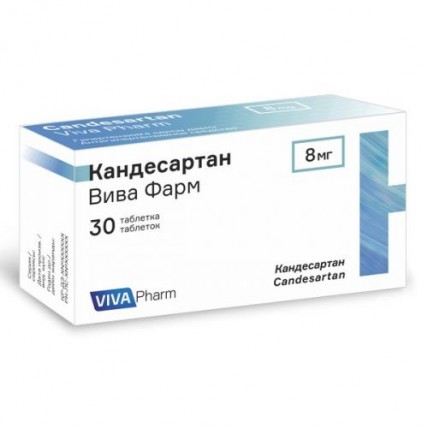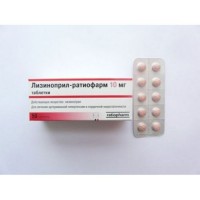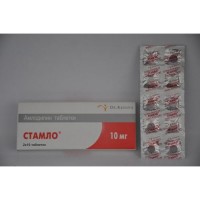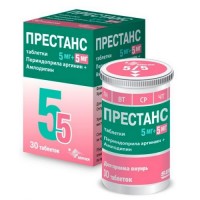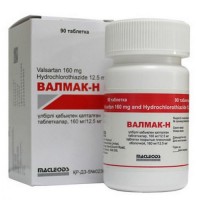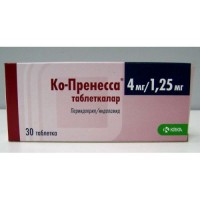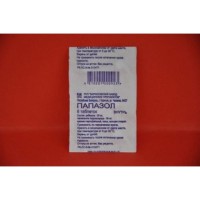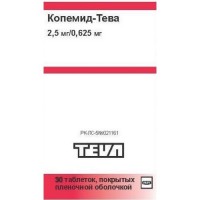Viva Pharm Candesartan 8 mg (30 tablets)
- $17.80
The instruction for medical use of KANDESARTAN medicine of Viv the Pharmaceutical Trade name Kandesartan of Viv the Pharmaceutical International unlicensed name Kandesartan Lekarstvennaya a form of the Tablet of 8 mg and 16 mg Structure One tablet contains active agent - a kandesartana tsileksetit 8 mg or 16 mg, excipients: lactoses monohydrate, starch corn, starch prezhelatinizirovanny, silicon dioxide colloidal (aerosil), hydroxypropyl cellulose 75-150 cps, macrogoal 8000, calcium of a karmelloz, magnesium stearate, ferrous oxide red (E 172). The description of the Tablet of white or almost white color, round shape with a flat surface, with a facet (for a dosage of 8 mg). Tablets of beige-pink color, round shape with a flat surface, with a facet and risky on one party. On a surface impregnations of white and dark red color are allowed (for a dosage of 16 mg). Pharmacotherapeutic group the Drugs influencing a system renin-angiotensin. Angiotensin II antagonists. Kandesartan. The ATX CO9CA06 code the Pharmacological Pharmacokinetics Absorption properties and distribution the Absolute bioavailability of a kandesartan after intake of solution of a kandesartan of a tsileksetil is about 40%. The relative bioavailability of the tableted drug in comparison with oral solution is about 34%. The maximum concentration in blood serum (Cmax) is reached in 3-4 hours after reception of the tableted drug form. Differences in pharmacokinetics of a kandesartan depending on a floor were not revealed. Meal had no significant impact on AUC of a kandesartan. Communication with proteins of plasma of a kandesartan high (more than 99%). The volume of distribution of a kandesartan is 0.1 l/kg. Metabolism and removal Kandesartan, is generally brought out of an organism with urine and bile in not changed look and only in insignificant degree is metabolized in a liver (CYP2C9). Data of researches did not reveal influence on CYP2C9 and CYP3A4. On the basis of the researches in vitro the interaction of a kandesartan with drugs which metabolism is mediated by isoenzymes of P450 CYP1A2, CYP2A6, CYP2C9, CYP2C19, CYP2D6, CYP2E1 or CYP3A4 cytochrome is not expected. Elimination half-life of a kandesartan makes about 9 hours. Cumulation of drug in an organism is not observed. The general clearance of a kandesartan is about 0:37 ml/min., at the same time renal clearance – about 0:19 ml/min. Renal excretion of a kandesartan is carried out by glomerular filtration and active canalicular secretion. After oral administration of a kandesartan, marked isotope 14C, about 26% of a dose are removed with urine in the form of a kandesartan and 7% in the form of an inactive metabolite, at the same time 56% of a dose are found in excrements in the form of a kandesartan and 10% in the form of an inactive metabolite. Pharmacokinetics in special groups of patients At elderly patients (65 years are more senior) Cmax and AUC of a kandesartan increased by 50% and 80% respectively in comparison with young patients. However, the hypotensive effect and frequency of side effects were similar. At patients with a slight and moderate renal failure of Cmax and AUC of a kandesartan increased by 50% and 70% respectively whereas elimination half-life of drug does not change. At patients with a heavy renal failure of Cmax and AUC of a kandesartan increased by 50% and 110% respectively, and elimination half-life of drug increased twice. The patients who are on a hemodialysis had a similar pharmacokinetics to that at patients with a heavy renal failure. At patients with a slight and moderate abnormal liver function of Cmax and AUC of a kandesartan increased by 20%. At patients with a heavy abnormal liver function of Cmax and AUC of a kandesartan increased by 80%. Data on use for patients with a heavy liver failure and/or a cholestasia are limited. Pharmacodynamics Angiotensin II – the main hormone the system renin-angiotensin-aldosteronovoy playing an important role in pathophysiological mechanisms of hypertensia, heart failure and other cardiovascular diseases and also in pathogenesis of an organ hypertrophy and defeat. The main physiological effects of angiotensin II are vasoconstriction, stimulation of products of Aldosteronum, regulation of a water and electrolytic homeostasis and stimulation of cellular growth. All these effects are mediated by interaction of angiotensin II with angiotenzinovy receptors of 1 type (AT1-receptors). Kandesartan tsileksetit is pro-medicine for oral administration. By means of radio hydrolysis at absorption from a digestive tract, kandesartan tsileksetit quickly turns into active agent – kandesartan which strongly contacts angiotenzinovy receptors of 1 type (AT1-receptors) and slowly dissociates, has no properties of agonist. Kandesartan – the selection antagonist of receptors of angiotensin II of 1 type (AT1-receptors). Kandesartan does not inhibit the angiotensin-the converting enzyme (ACE) which carries out transformation of angiotensin I into angiotensin II and destroys bradykinin. Does not influence AKF and does not lead to bradykinin accumulation. When comparing a kandesartan with AKF inhibitors the development of cough in patients met less often. Kandesartan does not contact receptors of other hormones and does not block the ion channels participating in regulation of functions of a cardiovascular system. Blocking of AT1 of receptors of angiotensin II is resulted by dose-dependent increase in level of renin, angiotensin I, angiotensin II and decrease in concentration of Aldosteronum in blood plasma. In arterial hypertension Kandesartan causes a dose-dependent long lowering of arterial pressure (ABP). The antihypertensive effect of drug is caused by decrease in the general peripheric resistance of vessels, without change of the heart rate (HR). Cases of the expressed arterial hypotension after reception of the first dose of drug and also effect of cancellation (syndrome of ricochet) after the therapy termination were not noted. The beginning of antihypertensive action after reception of the first dose of Kandesartan usually develops within 2 hours. Against the background of the continuing therapy kandesartany in the fixed dose the maximum decrease in the ABP usually is reached within 4 weeks and remains throughout treatment. Kandesartan appointed once a day provides effective and smooth decrease in the ABP within 24 hours with insignificant fluctuations of the ABP in intervals between receptions of the next dose of drug. Kandesartan can be used both in monotherapy, and in a combination with other antihypertensive drugs, such as thiazide diuretics and dihydropyridinic antagonists of calcium, for increase in efficiency. The efficiency of drug does not depend on age and sex of patients. Kandesartan increases a renal blood stream and does not change or increases the glomerular filtration rate whereas the renal vascular resistance and filtrational fraction decrease. Kandesartan's reception in a dose of 8-16 mg within 12 weeks has no negative impact on the level of glucose and a lipidic profile at patients with arterial hypertension and diabetes of the II type. At patients with chronic heart failure and reduced systolic function of a left ventricle (ФВЛЖ<, 40%), Kandesartan's reception promoted decrease in the general peripheric vascular resistance and capillary pressure in lungs, to increase in activity of renin and concentration of angiotensin II in plasma and also to decrease in level of Aldosteronum. Indications - arterial hypertension - chronic heart failure for decline in mortality, frequencies of hospitalization because of HSN and improvement of symptoms. The route of administration and doses Kandesartan of Viv Pharm should be accepted regardless of meal once a day. Arterial hypertension the Recommended initial and maintenance dose Kandesartan of Viv Pharm makes 8 mg once a day. Patients who need a further lowering of arterial pressure are recommended to increase a dose to 16 mg once a day. The maximum antihypertensive effect is reached within 4 weeks from an initiation of treatment. If therapy by Kandesartan does not lead to a lowering of arterial pressure to optimum level, it is recommended to add thiazide diuretic to therapy. Patients with a renal failure the change of an initial dose of drug is not required From patients with a slight or moderate renal failure (clearance of creatinine & gt, 30 ml/min.). Clinical experience of use of drug for patients with a heavy renal failure (clearance of creatinine & lt, 30 ml/min.) is limited, in this case it is necessary to consider the possibility of an initiation of treatment from a daily dose of 4 mg. Patients with an abnormal liver function the change of an initial dose of drug is not required From patients with an abnormal liver function easy and moderate severity. Clinical experience of use for patients with severe damages of a liver and/or a cholestasia is limited, in this case it is necessary to consider the possibility of an initiation of treatment from a daily dose of 4 mg. Chronic heart failure the Recommended initial dose Kandesartan of Viv Pharm makes 4 mg once a day. Increase in a dose to 32 mg or to the most tolerable dose is carried out once a day by its doubling with intervals not less than 2 weeks. Special groups of patients Patients of advanced age and patients with a renal failure do not need change of an initial dose of drug. The accompanying therapy Kandesartan of Viv Pharm can be appointed with other drugs for treatment of chronic heart failure, including AKF inhibitors, beta-blockers, diuretics or their combinations. Use for children and teenagers Safety and efficiency of use of a kandesartan for children and teenagers (aged up to 18 years) are not established. Side effects Side reactions at reception of a kandesartan easy and temporary. The general frequency of emergence of side reactions indicates dependence on a dose or age. Determination of frequency of by-effects is carried out according to the following criteria: very often (≥ 1/10), it is frequent (≥ from 1/100 to & lt, 1/10), infrequently (≥ from 1/1000 to & lt, 1/100), is rare (≥ 1/10000 to & lt, 1/1000), is very rare (& lt, 1/10000). Arterial hypertension Often (≥1/100 до<, 1/10) - dizziness / vertigo, a headache. - respiratory infections It is very rare (& lt, 1/10000) - a leukopenia, a neutropenia and an agranulocytosis - a hyperpotassemia, a hyponatremia - cough - nausea - increase in level of hepatic enzymes, an abnormal liver function or hepatitis - a Quincke's disease, skin rash, a small tortoiseshell, an itching - a dorsodynia, an arthralgia, myalgia. - disturbance of renal function, including a renal failure at patients, inclined to it. - in general clinically significant influence of a kandesartan on laboratory indicators is not observed. At use of other inhibitors, renin-angiotensin-aldosteronovoy of a system is noted small decrease in level of hemoglobin. For the patients receiving kandesartan the constant control of laboratory indicators usually is not necessary. However patients with a renal failure are recommended to carry out periodically control of level of potassium and creatinine in blood serum. Heart failure Often (≥1/100 до<, 1/10) - arterial hypotension - a hyperpotassemia - a renal failure Very seldom (& lt, 1/10000) - a leukopenia, a neutropenia and an agranulocytosis - a hyponatremia - dizziness, a headache - cough - nausea - increase in level of hepatic enzymes, an abnormal liver function or hepatitis - a Quincke's disease, skin rash, a small tortoiseshell, an itching - a dorsodynia, an arthralgia, myalgia. - disturbance of renal function, including a renal failure at patients, inclined to it. Periodic monitoring of levels of creatinine and potassium in blood serum is recommended. Contraindications - hypersensitivity to a kandesartan and other components of drug - pregnancy and the period of a lactation - the profound abnormal liver functions and/or a cholestasia - use of a kandesartan tsileksetit in a combination with the drugs containing aliskiren at patients with diabetes (1 or 2 types) or with a moderate or heavy renal failure (SKF & lt, 60 ml/min. / 1.73 sq.m) - children's age up to 18 years Medicinal interactions In clinical trials on pharmacokinetics was studied the combined use of a kandesartan with Hydrochlorthiazidum, warfarin, digoxin, oral contraceptives (ethinylestradiol / levonorgestrel), glibenclamide, nifedipine and enalapril. Clinically significant medicinal interactions were not revealed. At the combined prescribing of drugs of lithium with AKF inhibitors it was reported about reversible increase in concentration of lithium in blood serum and development of toxic reactions. Similar reactions can meet also when using antagonists of receptors of angiotensin II in this connection it is recommended to control lithium level in blood serum at the combined use of these drugs. Easing of antihypertensive effect at simultaneous use of antagonists of receptors of angiotensin II (APA-II) and non-steroidal anti-inflammatory drugs (NPVS is possible, including selection TsOG-2 inhibitors, acetylsalicylic acid (& gt, 3 g a day) and non-selective NPVS). As well as in case of AKF inhibitors, combined use of APA-II and NPVS can lead to increase in risk of deterioration in function of kidneys, including an acute renal failure and also increase in level of potassium in blood plasma, especially at patients with already broken renal function. It is necessary to appoint this combination with care, especially, at elderly patients and patients with a hypovolemia. It is necessary to carry out adequate hydration and monitoring of function of kidneys after the beginning of combination therapy and in the course of treatment. The antihypertensive effect of a kandesartan can amplify at intake of other antihypertensive drugs. The bioavailability of a kandesartan does not depend on meal. The special indications Renal Failure Against the background of of therapy kandesartany, as well as at use of other drugs oppressing renin-angiotensin-aldosteronovuyu a system for some patients can be noted renal failures. At use of a kandesartan for patients with arterial hypertension and the profound renal failure it is recommended to control periodically the level of potassium and creatinine in blood serum. Clinical experience of use of drug for patients with a heavy renal failure or an end-stage of a renal failure is limited (clearance of creatinine & lt, 15 ml/min.). At patients with heart failure it is necessary to control function of kidneys periodically. At increase in a dose of a kandesartan it is also recommended to control the level of potassium and creatinine. A renal artery stenosis with a bilateral renal artery stenosis or a stenosis of an artery of the only kidney the drugs influencing renin-angiotensin-aldosteronovuyu a system, in particular AKF inhibitors can cause increase in level of urea and creatinine in blood serum In patients. Similar effects can be expected at appointment of antagonists of receptors of angiotensin II. Renal transplantation Data on use of a kandesartan for the patients who recently transferred renal transplantation no. Arterial hypotension At patients with heart failure against the background of therapy of a kandesartan can develop arterial hypotension. As well as at use of other drugs influencing renin-angiotensin-aldosteronovuyu a system, reduction of volume of the circulating blood as it is observed at the patients receiving high doses of diuretics can be the cause of development of arterial hypotension in patients with arterial hypertension. Therefore at the beginning of therapy it is necessary to be careful and, if necessary, to carry out correction of a hypovolemia. Liver failure Data on use kandesartan at patients with a liver failure are limited. The general anesthesia and surgery At the patients receiving antagonists of angiotensin II during anesthesia and at surgical interventions can develop arterial hypotension as a result of blockade system renin-angiotenzinovoy. Very seldom cases of the heavy arterial hypotension demanding intravenous administration of liquid and/or vazopressor can be noted. A stenosis of the aortal and mitral valve or a subaortic hypertrophic stenosis When assigning a kandesartan, as well as others of a vazoda
of atator, patients should be careful with a subaortic hypertrophic stenosis or hemodynamically significant stenosis of the aortal or mitral valve. The hyperpotassemia Clinical experience of use of other drugs influencing a system renin-angiotensin-Aldosteronum shows that co-administration of a kandesartan with the kaliysberegayushchy diuretics, drugs of potassium or substitutes of salt containing potassium or other drugs which can increase potassium content in blood (for example, heparin) can lead to development of a hyperpotassemia in patients with arterial hypertension. At patients with heart failure against the background of therapy kandesartany, the hyperpotassemia can develop. When assigning a kandesartan the patients with heart failure are regularly recommended to control potassium level in blood, especially at joint appointment with AKF inhibitors and kaliysberegayushchy diuretics, such as Spironolactonum. The general Patients who have a vascular tone and function of kidneys mainly depend on activity system renin-angiotensin-aldosteronovoy (for example, patients with heavy chronic heart failure or diseases of kidneys, including a renal artery stenosis), are especially sensitive to the drugs operating on renin-angiotensin-aldosteronovuyu a system. Prescribing of similar drugs is followed at these patients with sharp arterial hypotension, an azotemia, oliguria less often – an acute renal failure. The sharp lowering of arterial pressure at patients with an ischemic cardiopathy or cerebrovascular diseases of ischemic genesis, when using any antihypertensive drugs, can lead to development of a myocardial infarction or stroke. Due to existence in composition of lactose of monohydrate, drug is not recommended to be used at hereditary intolerance of a galactose, deficiency of Lappa lactase or malabsorption of a glucose/galactose. Pregnancy Use of a kandesartan at pregnancy is contraindicated. The patients applying kandesartan have to be informed that before planning of pregnancy they should discuss options of possible hypotensive therapy with the attending physician. If pregnancy occurred during treatment kandesartany, therapy has to be stopped, if necessary alternative treatment has to be begun. The means applied at pregnancy making direct impact on renin-angiotensin-aldosteronovuyu a system can become the reason of pre-natal and neonatal povrezheniye and death. It is known that therapy by antagonists of receptors of angiotensin II causes fetotoksichesky effects in a human fruit (depression of function of kidneys, an oligoamnios, a hypoplasia of bones of a skull) or has negative effect on the newborn (renal failure, hypotension, a hyperpotassemia). The lactation period it is unknown Now whether gets kandesartan into breast milk. Due to the possible undesirable action on babies, kandesartan it should not be applied during breastfeeding. Features of influence of medicine on ability to run the vehicle or potentially dangerous mechanisms Influence of a kandesartan on ability to run motor transport was not studied, but based on pharmakodinamichesky properties, such influence is improbable. During the driving or work with mechanisms it is necessary to consider that during therapy there can be dizziness. Overdose Symptoms: profound arterial hypotension and dizziness. Treatment: symptomatic. To lay the patient on a back, to raise legs. If necessary it is necessary to increase the volume of the circulating plasma, for example, by intravenous administration of isotonic solution of sodium chloride. Sympathomimetic drugs can be in case of need appointed. Removal of a kandesartan by means of a hemodialysis is improbable. The form of release and packing On 10 tablets place in blister strip packaging from a film of polyvinylchloride and aluminum foil. On the 3rd blister strip packagings together with the approved instruction for medical use in the state and Russian languages place in a cardboard pack. To Store storage conditions at a temperature not above 25 °C. To store in the places inaccessible for children! Period of storage 2 years. Not to apply after an expiration date. Prescription status According to the prescription. VIVA Pharm LLP producer, Republic of Kazakhstan 2nd Ostroumova St., 33, Almaty the Owner of the registration certificate of VIVA Pharm LLP, Republic of Kazakhstan 2nd Ostroumova St., 33, Almaty the Address of the organization in the territory of the Republic of Kazakhstan, the accepting claim (offer) on quality of medicines and responsible for post-registration observation of safety of medicine: VIVA Pharm LLP, Republic of Kazakhstan 2nd Ostroumova St., 33, Almaty, 050030
to Develop
of atator, patients should be careful with a subaortic hypertrophic stenosis or hemodynamically significant stenosis of the aortal or mitral valve. The hyperpotassemia Clinical experience of use of other drugs influencing a system renin-angiotensin-Aldosteronum shows that co-administration of a kandesartan with the kaliysberegayushchy diuretics, drugs of potassium or substitutes of salt containing potassium or other drugs which can increase potassium content in blood (for example, heparin) can lead to development of a hyperpotassemia in patients with arterial hypertension. At patients with heart failure against the background of therapy kandesartany, the hyperpotassemia can develop. When assigning a kandesartan the patients with heart failure are regularly recommended to control potassium level in blood, especially at joint appointment with AKF inhibitors and kaliysberegayushchy diuretics, such as Spironolactonum. The general Patients who have a vascular tone and function of kidneys mainly depend on activity system renin-angiotensin-aldosteronovoy (for example, patients with heavy chronic heart failure or diseases of kidneys, including a renal artery stenosis), are especially sensitive to the drugs operating on renin-angiotensin-aldosteronovuyu a system. Prescribing of similar drugs is followed at these patients with sharp arterial hypotension, an azotemia, oliguria less often – an acute renal failure. The sharp lowering of arterial pressure at patients with an ischemic cardiopathy or cerebrovascular diseases of ischemic genesis, when using any antihypertensive drugs, can lead to development of a myocardial infarction or stroke. Due to existence in composition of lactose of monohydrate, drug is not recommended to be used at hereditary intolerance of a galactose, deficiency of Lappa lactase or malabsorption of a glucose/galactose. Pregnancy Use of a kandesartan at pregnancy is contraindicated. The patients applying kandesartan have to be informed that before planning of pregnancy they should discuss options of possible hypotensive therapy with the attending physician. If pregnancy occurred during treatment kandesartany, therapy has to be stopped, if necessary alternative treatment has to be begun. The means applied at pregnancy making direct impact on renin-angiotensin-aldosteronovuyu a system can become the reason of pre-natal and neonatal povrezheniye and death. It is known that therapy by antagonists of receptors of angiotensin II causes fetotoksichesky effects in a human fruit (depression of function of kidneys, an oligoamnios, a hypoplasia of bones of a skull) or has negative effect on the newborn (renal failure, hypotension, a hyperpotassemia). The lactation period it is unknown Now whether gets kandesartan into breast milk. Due to the possible undesirable action on babies, kandesartan it should not be applied during breastfeeding. Features of influence of medicine on ability to run the vehicle or potentially dangerous mechanisms Influence of a kandesartan on ability to run motor transport was not studied, but based on pharmakodinamichesky properties, such influence is improbable. During the driving or work with mechanisms it is necessary to consider that during therapy there can be dizziness. Overdose Symptoms: profound arterial hypotension and dizziness. Treatment: symptomatic. To lay the patient on a back, to raise legs. If necessary it is necessary to increase the volume of the circulating plasma, for example, by intravenous administration of isotonic solution of sodium chloride. Sympathomimetic drugs can be in case of need appointed. Removal of a kandesartan by means of a hemodialysis is improbable. The form of release and packing On 10 tablets place in blister strip packaging from a film of polyvinylchloride and aluminum foil. On the 3rd blister strip packagings together with the approved instruction for medical use in the state and Russian languages place in a cardboard pack. To Store storage conditions at a temperature not above 25 °C. To store in the places inaccessible for children! Period of storage 2 years. Not to apply after an expiration date. Prescription status According to the prescription. VIVA Pharm LLP producer, Republic of Kazakhstan 2nd Ostroumova St., 33, Almaty the Owner of the registration certificate of VIVA Pharm LLP, Republic of Kazakhstan 2nd Ostroumova St., 33, Almaty the Address of the organization in the territory of the Republic of Kazakhstan, the accepting claim (offer) on quality of medicines and responsible for post-registration observation of safety of medicine: VIVA Pharm LLP, Republic of Kazakhstan 2nd Ostroumova St., 33, Almaty, 050030
to Develop
